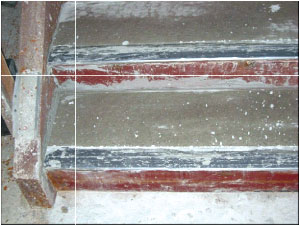Stair Treads and Nosings
Accurate visual representation. The BIM model needs to predict the built condition as closely and as accurately as possible. Hence the same is true with building products that are inserted as objects into that model. It is important that the visual characteristics of the computerized object match the detail and properties of the actual physical object. This is easily revealed by comparing the computerized object to photos or samples of the physical object and looking for similarities and discrepancies in details and features.
Complete embedded information. This is where the value of BIM for products really shines. All of the relevant information associated with a selected product should be readily accessed and readable from the BIM object. That means that manufacturers' make and model numbers, full product specifications, cost/pricing information, production and delivery requirements should all be readily available. For the long-term benefit of the owner, it should also include a link to the warranty, maintenance, and replacement information related to the product.
 |
Over filling or over spraying of concrete in metal pan stairs can damage the stair nosings and render their slip resistance to be compromised. Photo courtesy of Nystrom, Inc. |
Parametric modeling capability. Most BIM software programs allow for automated interaction between different objects. This interaction is governed by a set of computer programming rules that an object must follow anytime a modification or insertion of an object is made. This process is referred to as parametric modeling and is one of the key advantages of using BIM. It means that an object not only provides data about itself, it also has the ability to interact with the rest of the model, such that a change in the object triggers a corresponding change to other parts of the model. For example, inserting a tread into a stair means that the concrete stair has to change to accommodate it. If the tread is one of several and a schedule or chart is part of the model summarizing the details of all of them, then the schedule has to be updated. And if a particular tread has several options built into it, the selection of those options should automatically be reflected in all aspects of the model. In simple terms, parametric modeling is the means to make this all happen.
Complete and open interoperability. Anyone who has ever tried to open a computer file that produced either an error message related to non-compatibility or a display of unintelligible characters will readily understand the need for seamless integration of information from multiple sources. That is what is meant by interoperability—the ability to access complete and accurate information regardless of the source of the different parts of the information. The data from building manufacturers, then, needs to be provided in a format that is accessible by all software identified as important on the project.
Overall, then, while the use of BIM may not be the only way to design a building, it certainly is emerging as a preferred way by many project teams. Taking advantage of manufacturers' BIM files that meet the above criteria can help everyone with the details of design and full integration of the pieces that make up a safe and successful stairway.
Installation and Cleaning
Anti-slip metal safety stair nosings and treads are designed to be installed fully embedded into a substrate such as concrete or secured directly over a flat surface such as wood or existing concrete, any of which need to provide total support for the stair nosing. Actual installation of metal treads and nosings will obviously vary, then, based on the types of stairs they are being installed upon. Wood stair installations are perhaps the most straightforward, in that the wood stairs first simply need to be complete and clean. Then, the metal safety stair treads are simply screw attached to the wood treads and are ready to use.
For cast concrete or metal pan concrete filled stairs, the installation may require a bit more diligence for a successful outcome. Once all of the aluminum products are staged for installation and the concrete forms or metal pans are ready, then the concrete should be poured. Next, the safety nosings should be placed into position in the concrete. Installers need to tamp the safety nosings to insure proper concrete formation around the anchors on the underside and eliminate any voids. This action will prevent the occurrence of hollows and voids, which can lead to flexing and cantilevering of the nosing. Therefore, it is vital that the installer tamp down the stair nosing to totally seat it into the substrate and fully rest upon any riser return such as in pan-filled steps.
Note that metal safety nosing placement may be difficult in concrete with a very low slump (mass). Be certain the concrete mix is of the proper consistency: not too dry, not too wet. Further, the use of very large aggregate in the concrete mix may make installation of the safety nosings difficult and should be avoided. Concrete installers should be aware that over-spraying of the concrete can fill the abrasive area with a concrete coating that will render the slip resistance and appearance ineffective. Further, aggressive finishing and overflow of the concrete has the potential to crack a full abrasive tread or nosing or dislodge the abrasive material from the treads altogether. Obviously, all of these adverse conditions need to be avoided. However, in the event they do happen, manufacturers can provide repair kits for small areas that have been damaged or abused. Note however that repair kits are primarily for aesthetic purposes and do not offer the same stability of treads manufactured at the factory. Typically the kits are shipped with three components—the abrasive in any of the standard colors specified, epoxy hardener, and epoxy resin. Manufacturers' instructions must be followed carefully when using these repair kits to assure that the finished outcome is fairly consistent with the rest of the installation. If defects are found in the material itself, rather than an installation issue, then the products should be covered under a one-year warranty. In that case, they will need to be exchanged or replaced which means that inspecting the products before they are installed in concrete will be much better than afterwards.
For renovation stair tread installation, the industry standard is to provide a 9-inch-deep renovation tread on each step and an 11-inch-deep tread at the top of each run at each intermediate landing. Renovation tread widths should be determined by measuring the width of the existing step to be covered and deducting 6 inches to provide a 3-inch margin at each side. Existing stairs that are badly worn or dished will need to be re-leveled with a fast-setting leveling compound such as an underlayment and patching compound. This will provide a level surface for installation of the renovation treads and usually sets in two to four hours. Once all is ready, the treads can be installed. Renovation treads are typically furnished with two rows of drilled and countersunk holes. An application of construction adhesive to the underside perimeter of the renovation tread as well as around each drilled hole will stop water penetration under the tread. On wooden steps, renovation treads are fastened with wood screws. For attachment to metal steps, bolts and nuts or self-tapping screws can be used. For masonry steps, expansion shields and screws are typical. On any type of exterior stair, most manufacturers recommend stainless steel fasteners. After installation of the renovation treads, the exposed areas of the existing steps, stringers, and risers can be painted to create a fully finished appearance.
Cleaning and maintenance of all of these products is fairly straightforward to specify both at the end of construction and during use. Treads should be swept with a broom or vacuumed with a heavy-duty commercial vacuum cleaner at least once a week. When needed, scrub surfaces vigorously with a stiff bristled brush using a mild detergent but do not use any product containing solvents such as acetone. Rinse thoroughly with water after cleaning. Scuff marks on the aluminum nose can be removed by rubbing with a fine steel wool and a commercial cleaning agent. To remove snow and ice on exterior stairs, sodium chloride salt can be used.
Conclusion
Manufactured safety treads and nosings are available to be incorporated into stairs in literally dozens of styles of extruded aluminum and cast type products. Products can be selected that are suitable for either new construction or renovation and for interior and exterior stairs. They are specifically designed to offer choices that are compatible with wood stairs, poured concrete stairs, metal pan concrete stairs, renovations, and ramps. They create a safe stair environment that complies with building codes and OSHA regulations as well as barrier-free codes and standards for the physically impaired. They are specifically manufactured with epoxy abrasive materials that produce superior slip resistance in a variety of colors that are locked into the epoxy abrasive mixture and will not fade or wear off. Designing and specifying such safety treads and nosings into stairs and ramps produce safer walking surfaces for all users of those areas. They also meet a reasonable standard of care for providing safe environments as part of architectural practice.
 |
Nystrom is a global supplier of complementary building products and services which include miscellaneous and specialty construction items. Nystrom partners with clients to simplify specifying and procurement—minimizing cost and time associated with the construction project workflow. www.nystrom.com |








